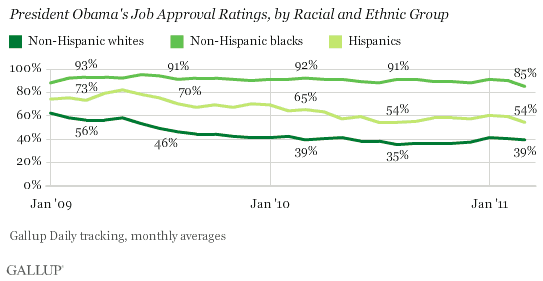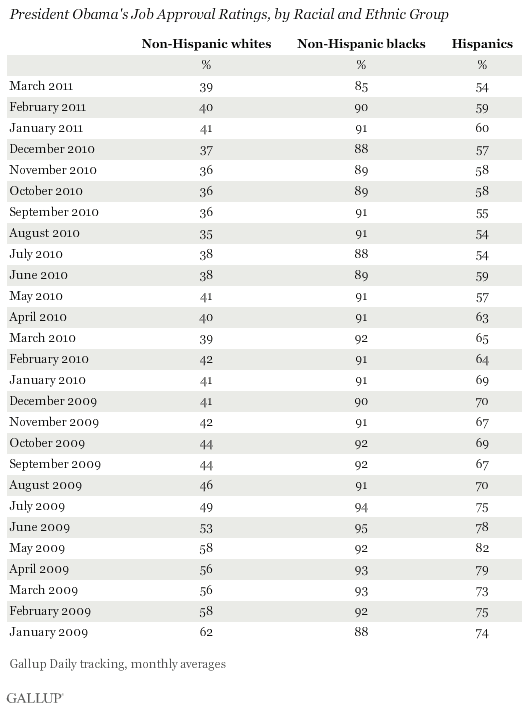PRINCETON, NJ -- Though majorities of blacks (85%) and Hispanics (54%) continue to approve of the job Barack Obama is doing as president, his ratings among these groups slipped in March and have set or tied new lows. His approval rating among whites, at 39%, remains above where it was in the latter part of 2010.

These results are based on aggregated data from Gallup Daily tracking in March, including more than 15,000 interviews with U.S. adults. Overall, Obama averaged 47% approval in March, three percentage points above his term low from August 2010.
Obama, elected to office with strong support from minority voters, has averaged better than 90% approval among blacks, and 65% among Hispanics, during his term. Prior to March, Obama's lowest monthly average among blacks was 88% in July 2010 and December 2010. The president's 54% March job approval rating among Hispanics ties the low from July and August 2010. For the complete monthly trend, please see page 2.
Even with the decline in blacks' ratings of Obama, blacks remain the most likely to approve of him among key attitudinal or demographic subgroups. Democrats (80%) and self-identified liberals (74%) are next. Republicans show the lowest level of support by a wide margin, at 14%.
In addition to the vast racial differences in views of his performance, Obama's approval ratings continue to be more positive among the young than among the old, nonmarried than married, highly educated than less educated, lower income than higher income, and less religious than more religious.

The racial divide in opinions of Obama has been consistent throughout his presidency. The gap grew as large as 56 points last August (91% approval among blacks vs. 35% among whites). The current gap of 46 points is slightly lower, but still considerably larger than the average 34-point gap in the first five months of his presidency.
Implications
It is not clear what is behind blacks' and Hispanics' less positive evaluations in March than in prior months. The major events of the month were the U.S. involvement in military action in Libya and the negotiations over the federal budget. Obama's overall job approval rating remains above his term low from last August, mostly because whites are more supportive of him now than they were back then.
Blacks and Hispanics will likely remain among Obama's strongest supporters, and a key to his re-election bid next year will be his ability to maintain their support.
Survey Methods
Results are based on telephone interviews conducted as part of Gallup Daily tracking March 1-31, 2011, with a random sample of 15,744 adults, aged 18 and older, living in all 50 U.S. states and the District of Columbia, selected using random-digit-dial sampling.
For results based on the total sample of national adults, one can say with 95% confidence that the maximum margin of sampling error is ±1 percentage points.
For results based on the sample of 12,162 non-Hispanic whites, the maximum margin of sampling error is ±1 percentage points.
For results based on the sample of 982 non-Hispanic blacks, the maximum margin of sampling error is ±4 percentage points.
For results based on the sample of 1,034 Hispanics, the maximum margin of sampling error is ±4 percentage points.
The questions reported here are asked of a random half-sample of respondents each month on the Gallup Daily tracking survey.
Interviews are conducted with respondents on landline telephones and cellular phones, with interviews conducted in Spanish for respondents who are primarily Spanish-speaking. Each daily sample includes a minimum quota of 200 cell phone respondents and 800 landline respondents, with additional minimum quotas among landline respondents for gender within region. Landline respondents are chosen at random within each household on the basis of which member had the most recent birthday.
Samples are weighted by gender, age, race, Hispanic ethnicity, education, region, adults in the household, cell phone-only status, cell phone-mostly status, and phone lines. Demographic weighting targets are based on the March 2010 Current Population Survey figures for the aged 18 and older non-institutionalized population living in U.S. telephone households. All reported margins of sampling error include the computed design effects for weighting and sample design.
In addition to sampling error, question wording and practical difficulties in conducting surveys can introduce error or bias into the findings of public opinion polls.
For more details on Gallup's polling methodology, visit www.gallup.com.

